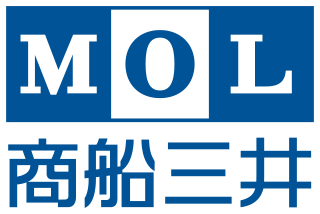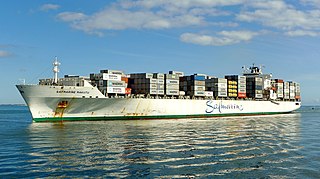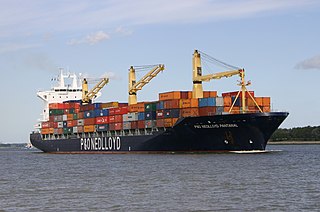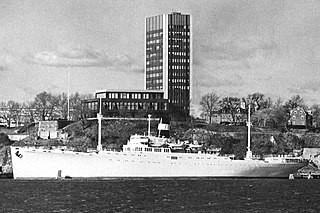
Mitsui O.S.K. Lines is a Japanese transport company headquartered in Toranomon, Minato, Tokyo, Japan. It is one of the largest shipping companies in the world.

APL, formerly called American President Lines Ltd., is an American container shipping company that is a subsidiary of French shipping company CMA CGM. It operates an all-container ship fleet, including nine U.S. flagged container vessels.

A.P. Møller – Mærsk A/S, also known simply as Maersk, is a Danish shipping company, active in ocean and inland freight transportation and associated services, such as supply chain management and port operation. Maersk was the largest container shipping line and vessel operator in the world from 1996 until 2022. The company is based in Copenhagen, Denmark, with subsidiaries and offices across 130 countries and around 83,000 employees worldwide in 2020.
The 4 Aces were the quartet of passenger-cargo liners Excalibur, Exochorda, Exeter, and Excambion, originally built for American Export Lines by New York Shipbuilding of Camden, New Jersey between 1929 and 1931. AEL placed the "4 Aces" in service between the US and the Mediterranean, offering cruises of up to 40 days.

Safmarine, short for South African Marine Corporation, and latterly South African Marine Container Lines, was a South African shipping line, established in 1946, which offered freight transport services with cargo liners and container ships. It was bought by Maersk Line in 1999, and was fully integrated into that company in 2020. It also operated passenger vessels and specialised cargo ships.

CP Ships was a large Canadian shipping company established in the 19th century. From the late 1880s until after World War II, the company was Canada's largest operator of Atlantic and Pacific steamships. Many immigrants travelled on CP ships from Europe to Canada. The sinking of the steamship RMS Empress of Ireland just before World War I was the largest maritime disaster in Canadian history. The company provided Canadian Merchant Navy vessels in World Wars I and II. Twelve vessels were lost due to enemy action in World War II, including the RMS Empress of Britain, which was the largest ship ever sunk by a German U-boat.

Hamburg Südamerikanische Dampfschifffahrts-Gesellschaft A/S & Co KG, widely known as Hamburg Süd, was a German container shipping company. Founded in 1871, Hamburg Süd was among the market leaders in the North–South trade. It also served all significant East–West trade lanes.

P&O Nedlloyd Container Line Limited was an Anglo-Dutch worldwide ocean-going container shipping line, with dual headquarters in London and Rotterdam. The company was formed in 1997 by the merger of the container-shipping interests of Dutch transportation company Royal Nedlloyd and the British maritime shipping giant P&O Group.

USS Venango (AKA-82) was a Tolland-class attack cargo ship in service with the United States Navy from 1945 to 1946. She was sold into commercial service and was scrapped in 1971.

The Stoomvaart Maatschappij Nederland or SMN, also known as the Netherland Line or Nederland Line, was a Dutch shipping line that operated from 1870 until 1970, when it merged with several other companies to form what would become Royal Nedlloyd.

SeaLand, a division of the Maersk Group, is an American intra-regional container shipping company headquartered in Miramar, Florida with representation in 29 countries across the Americas. The company offers ocean and intermodal services using container ships, trucks, and rail serving customers between North and South America, Central America, and the Caribbean.

USTS Texas Clipper, a 473 foot long ship, served as a merchant marine training vessel with the Texas Maritime Academy at Texas A&M University at Galveston for 30 years beginning in 1965. Her name is reflective of clipper ships of old, both designed with a characteristic rounded stern.
The A. P. Moller-Maersk Group is an international business conglomerate more commonly known simply as Maersk. This article concerns the history of the company.

SS Stevens, a 473-foot (144 m), 14,893-ton ship, served as a floating dormitory from 1968 to 1975 for about 150 students of Stevens Institute of Technology, a technological university, in Hoboken, NJ. Permanently moored on the scenic Hudson River at the foot of the campus across from New York City, this first collegiate floating dormitory became one of the best known college landmarks in the country.

SS Exochorda was a 473-foot, 14,500-ton cargo liner in service with American Export Lines from 1948 to 1959. A member of the line's post-war quartet of ships, "4 Aces", Exochorda sailed regularly from New York on a Mediterranean route. Originally built in 1944 as the military attack transport USS Dauphin (APA-97), the ship was extensively refurbished prior to her service as a passenger-cargo liner. Following her service as a cruise liner, the vessel served as the floating dormitory ship SS Stevens for the students of Stevens Institute of Technology, a technological university, in Hoboken, NJ. At the end of her service life she was scrapped, in 1979.

The Moore-McCormack Lines was a series of companies operating as shipping lines, operated by the Moore-McCormack Company, Incorporated, later Moore-McCormack Lines, Incorporated, and simply Mooremack, founded in 1913 in New York City. It ceased trading on its buy-out in 1982. The founders were Albert V. Moore (1880–1953) (director/president) and Emmet J. McCormack (director/treasurer), with Mr Molloy (director/secretary).
Farrell Lines Incorporated was a boat company named in 1948 after James A. Farrell, Jr., and John J. Farrell, sons of James Augustine Farrell, president of US Steel. The company was previously known as American South African Lines (ASAL). It was a passenger line and cargo line in regular service from New York City to South Africa stopping at Cape Town, Port Elizabeth, Durban and Lourenço Marques (Maputo) in Mozambique. The ships were well-appointed and carried about 180 passengers.

Maersk Line is a Danish international container shipping company and the largest operating subsidiary of the Maersk Group, a Danish business conglomerate. Founded in 1928, it is the world's largest container shipping company by both fleet size and cargo capacity, offering regular services to 374 ports in 116 countries. In 2019, it employed 83,625 people where 18,398 of which are vessel crew and the other 65,227 are processing and operations personnel in offices and ports.
SS Bates Victory was a World War II Victory ship named after Bates College in Maine.















